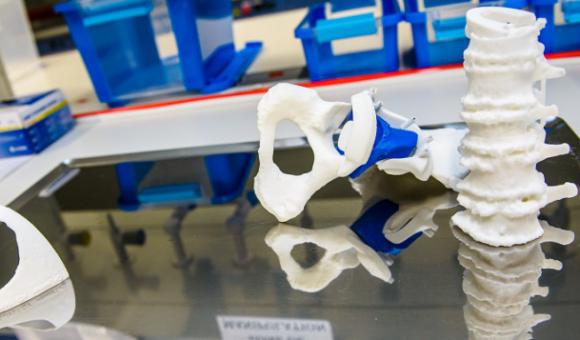
This Walloon company is at the forefront of technology in health! By reproducing in 3D parts of the body requiring treatment, it allows surgeons to treat bone tumours as effectively as possible as they operate.
Two men are changing the daily lives of hundreds of patients in Belgium now : Khanh Tran Duy and Laurent Paul, joint CEOs of the 3D-Side company. They and their team of four employees are opening up new possibilities for surgeons who remove bone tumours and for others who carry out cranial operations following devastating accidents. Their company markets three-dimensional implants for the well-being for patients.
Their main asset is indisputably their 3D high-precision printer. “Currently, our key products are for: tumour resections, cranial implants and the treatment of fractures,” says Laurent Paul. Their innovation is so cutting-edge that they have already been able to take the step of raising capital of one million euros in order to continue their research and promote it more effectively. They have relied on Vives, a private seed capital and risk investment fund that backs, in particular, projects involving green innovation, and on the Walloon life sciences incubator (WBC incubator) as well as Nivelinvest, Novallia and the SPW, the Public Services Department of the Walloon government (DGO6).
Limiting recurrences thanks to the precision of the work
3D-Side came into being following the merger of two SPRLs (private limited companies) started up by two PhD students in engineering from the UCL: CenTIS by Khanh Tran Duy, and Visyos by Laurent Paul. Today, this alliance has led to a new business set up in 250m² space of rented buildings in Louvain-la-Neuve. “Everything is produced here on our premises. One of our main advantages is that we have analysed the market and designed a different product while reducing the manufacturing time for templates and implants and going for more suitable and malleable materials (different from titanium or others often still used at present). The structures achieved are stronger and less expensive. Now, above all, we are designing the templates ourselves, which saves us production time. A crucial factor for surgeons who have to be able to operate immediately with very precise equipment,” explains Laurent Paul.
By way of example, for bone tumours, using a guide specially adapted for each patient, the excision can be done to a degree of accuracy within a margin of less than 3 mm, compared to 10 mm for a manual operation. “Our aim really is to limit recurrence thanks to the accuracy of the excision. We’ll never achieve 0% ... but, currently, we are reducing the risk of recurrence from 30 to 10-12%. This latter percentage is not necessarily linked to the bone that’s operated on; because it can come from tissue residue. We are, of course, currently working on studies with a supervision period of 5 years.”
Both adults and children
Bone or tumour surgeries are often very complicated. Based on scanner and MRI images reproduced in 3D, 3D-SIDE is capable of manufacturing refined instruments and bone models in the operating theatre in order to give the surgeon maximum effectiveness at the time of the operation. “When the image is received from the surgeon, the piece is designed virtually until it complies exactly with the request; then it’s made. These instruments allow for a reliable transfer from preoperative planning to within the operating theatre itself, thus improving the quality of the treatment and reducing operating time.”
After confirming the recomposed part of the bone, the surgeon receives the biocompatible mould of the bone and the instruments for the operation adapted for the patient. They are sterilised on the hospital site. “Today, our technical solutions are used both for adults and for children suffering from tumours of the bones, or from congenital malformations of the hip in the case of girls. In Belgium, we work with the Saint-Luc hospital, which has great expertise in using our products. But we also work with other hospitals of course,” adds Laurent Paul.
Cranial implants, used in neurosurgery to help the surgeon make up for missing material, are the other main asset of this young business. “Forehead, cranium, we currently have 98% of the market. We have already dealt with 25 cases in the French-speaking region and our first case in Flanders is underway.”
What’s more, they have just applied for a European patent for their cranioplasty technology.
Exporting... keen interest from India!
Many European countries, such as France, are following this technology, among other things because improving post-operative outcomes reduces any recurrences of the illness and, therefore, longer term, the health care costs for the State budget. “That really is one of our advantages: our product is less expensive and, above all, it reduces the risks of relapses. We can work anywhere in Europe (common product certification) but, each time, we have to come to an agreement with the social security of each country. That’s already done in Belgium. We’re currently in discussion with surgeons in India, who are interested in our product.” Other countries will, no doubt, be knocking on their door in the coming months!
Vincent Liévin





